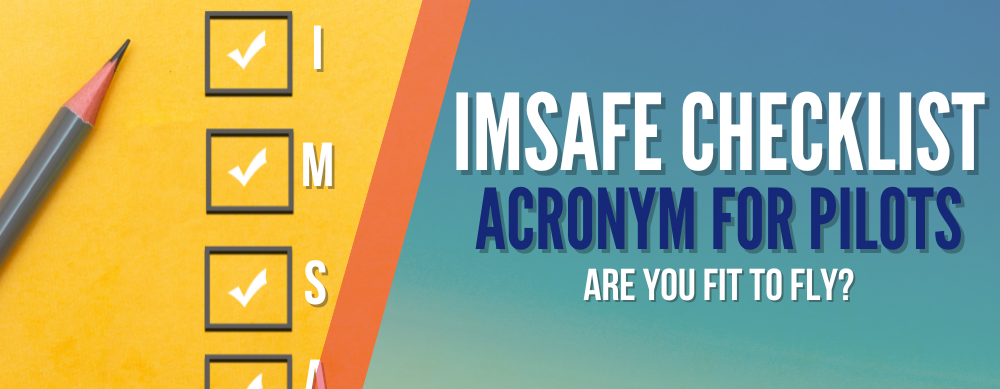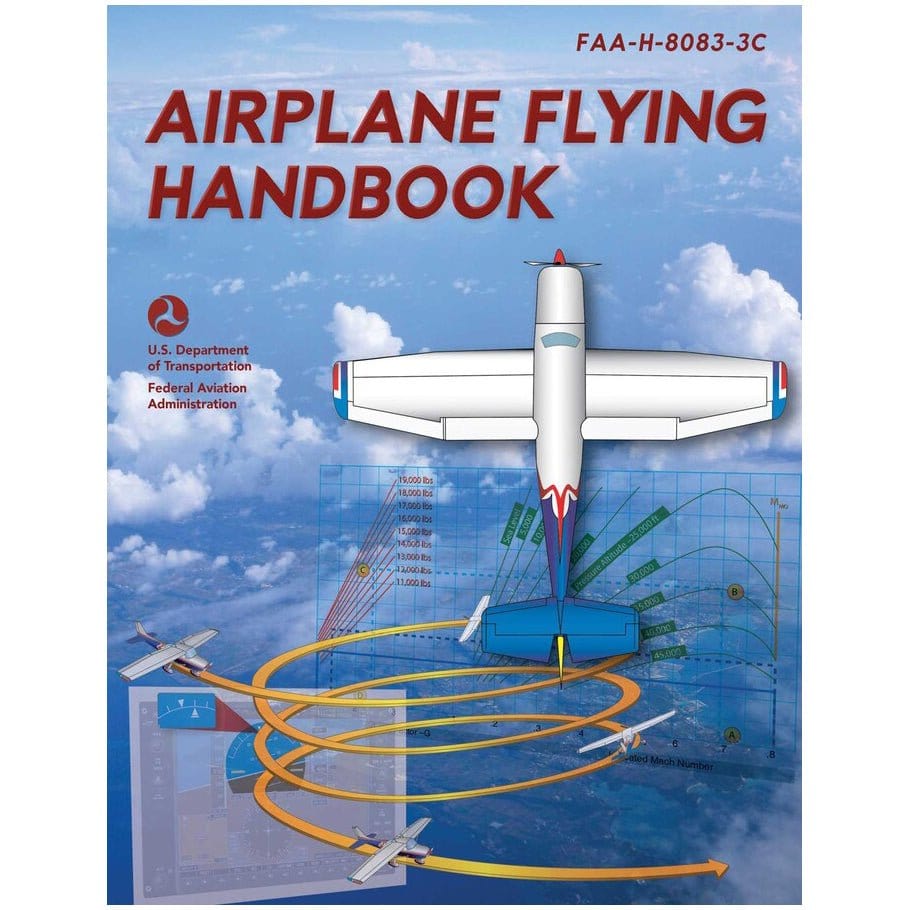When it comes to flight safety, there's a mantra every pilot—whether they're a 1000+hr seasoned pro or a budding student pilot—swears by: "IMSAFE." This isn't just another term from the FAA regulations manual, it's a foundational principle taught early on in flight training by every certified flight instructor.
IMSAFE is your personal pre-flight checklist for your own health and well-being, it's important for ensuring not just compliance, but pilot performance as well.
In this article, let's take a deep dive into what IMSAFE is all about and why it's going to help you fly safely.
Ready? Let's begin!
 What is IMSAFE?
What is IMSAFE?
Student pilots will quickly learn about the three checklist categories that have to be gone through before they can take flight:
- Checking the weather conditions
- Checking the aircraft
- Checking the pilot's ability to fly safely
You might be wondering, what does IMSAFE mean and why is it important? IMSAFE stands for: illness, medication, stress, alcohol, fatigue, and emotion.
The IMSAFE acronym is a safety checklist to help pilots self-assess their own personal well-being and determine if they can uphold the FAA's aeronautical decision-making standards and regulations, along with ensuring safety for themselves, the crew members, and passengers.
We will break down the IMSAFE checklist in the next section to detail what symptoms or issues fall under these categories so you can have a full grasp on what defines meeting the IMSAFE requirements.
 The Checklist
The Checklist
If you have already started your aviation journey, you have probably heard your flight instructor inform you that the IMSAFE checklist is a helpful tool, and an acronym that you will need to memorize and know not simply for your checkride, but use as a wellness check you ask yourself before every flight.
I - Illness
Physiological stress and sickness can significantly impact a pilot's ability to fly. If you are experiencing flu-like symptoms, unexpected physical ailments, or any illness it's best to simply make the decision to not go flying that day.
M - Medication
From over-the-counter medications to prescribed medications, what a pilot takes can either help or negatively affect their ability to fly. As a pilot you need to be aware of the FAA's approved medications and understand how certain drugs or medical conditions can impact one's capability in the cockpit.
S - Stress
Stress comes in a variety of forms—psychological stress, environmental stress, or a prolonged period of strain. Monitoring stress levels is an important task since high stress can directly influence a pilot's performance. Recognizing and managing stress is as equally vital as managing the aircraft's controls.
A - Alcohol
This item on the list should be obvious, and failing to follow it can potentially lead to the loss of your license. If you have consumed alcohol, the FAA recommends waiting for a strict "eight-hour bottle to throttle" policy to ensure safe flying.
Consuming alcohol can lead to impaired judgment, which is why you cannot fly under the influence of alcohol or with a blood alcohol content of 0.04 or greater.
Even though there is the "eight-hour" rule, we recommend avoiding alcohol a full 24 hours before you fly. This ensures that not only is the alcohol out of your system, but you'll feel great and less likely to feel the next item on the list—"fatigue".
F - Fatigue
Being adequately rested is non-negotiable in aviation. Learning how to manage fatigue is a judgment call that pilots need to take seriously, especially during a long flight.
Extreme fatigue or unusual weakness can compromise a pilot's ability to operate the aircraft in a safe manner.
You can fight fatigue effects by getting a full 8 hours of rest and avoiding strenuous exercise before performing flight operations.
Avoid relying on stimulants such as caffeine or energy drinks, since these can have an impact on your emotional and physical well-being.
E - Emotion (Eating, External Pressures)
Beyond the physical, other symptoms can include emotional issues and external factors can impact a pilot's mental state. Addressing psychological factors and external pressures, whether related to family problems or aircraft maintenance, is important for your safety.
The "E" can also stand for eating. Eating nutritional meals and steering clear of vending machine snacks can help reduce fatigue and encourage a pilot to be alert and mentally sharp during their flights.
 Staying Fit to Fly
Staying Fit to Fly
Developing good mental fitness and improving your physical fitness can be a great personal goal if your desire is to pursue a career as a professional pilot.
It can be a demanding job and the IMSAFE checklist is both a guide and a reminder that the physical, mental, and emotional well-being of a pilot matters just as much as checking the aircraft.
The day before a flight, most pilots develop a safety routine. They try to deal with any negative emotions and stress levels, choosing to remain calm and keeping those stressors away from the cockpit.
Many pilots engage in light exercises or activities to stay in good shape, enhancing their ability to handle flight operations and avoid doing rigorous exercises or routines before a flight.
Pilots should consult an Aviation Medical Examiner to make sure their medical certificate remains current and they discuss any concerns about over-the-counter medications or psychological stressors.
PAVE Checklist
Completing the PAVE checklist, and assessing Pilot, Aircraft, enVironment, and External Pressures, helps aid them in maintaining situational awareness.
Commercial pilots, in particular, will often collaborate closely with their co-pilot or crew members to collectively ensure everyone is fit to fly, both physically and mentally, thus maximizing safety in the skies.
If you don't go commercial, and decide to stay in general aviation, consider taking along a safety pilot to increase the overall security of your travels.

Takeaway
The IMSAFE checklist isn't just a routine, it helps you as a pilot to be honest with yourself and confront genuinely how you are feeling prior to flying.
Aviation professionals, by adopting this acronym into their pre-flight routine, want to make sure that safety isn't just a priority; it's a guarantee.
Consult with an Aviation Medical Examiner if you are on any medications to be sure you're fit to fly and factor it into your pre-flight checklists. The IMSAFE approach creates the essence of a safe flight in the aviation industry.
Remember, in the skies, the IMSAFE acronym isn't meant to keep you from being able to fly, it's there to help you make better judgment calls for a successful flight and to keep the skies protected.
You can learn more about risk management when it comes to flying by checking out the FAA's Risk management Handbook.

|
Gleim Online Safe Pilot CourseAviation safety is a crucial component of flying that no pilot can afford to neglect. To help you enjoy safe skies on every flight, the aviation-training experts at Gleim have developed a comprehensive online course loaded with tips, tactics, facts, and figures that will better equip you to avoid the hazards inherent to flying. |
Aviation Medical & Safety Related Articles
Now that you know more about the IMSAFE checklist, we recommend checking out our guides. These guides are designed to help student pilots become professional pilots and for private pilots to brush up on their knowledge and skills.
-
15 FAA Medical Certificate Disqualifying Conditions for Pilots
-
Preflight Checklists are Crucial to Safety (Download Checklist)
-
7 Types of Turbulence Every Pilot Should Know (What Causes It)
- 5 Hazardous Attitudes of Pilots – Which One Do You Have?
Did you find this article helpful?
Do you think we missed anything important about the IMSAFE checklist? Let us know in the comments below!







